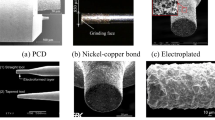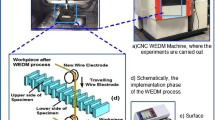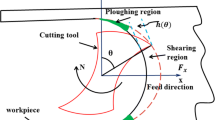Abstract
In this study, experiments were carried out to establish the effect of tool rake angle on the performance of single crystal diamond tools in micro-grooving of electroless nickel plated molding dies. Diamond tools with rake angles of 00,+50 and −50 were used in the study, and it was found that the diamond tool with 00 rake angle has superior performance in terms of tool wear, cutting forces, and machined surface roughness. For a cutting distance of up to 11.69 km, the 00 rake tool machined satisfactorily without any sign of tool wear while the tools with +50 and −50 rake angles suffered from progressive wear with a corresponding increase in cutting forces. However, it was noted that despite the increase in wear on tools with +50 and −50 rake angles, and cutting forces on the diamond tools with all three different rake angles did not significantly affect the surface roughness. The effects of various cutting parameters such as spindle speed and infeed rate on the cutting forces and surface roughness are also presented in the study. It was observed that cutting forces increase proportionately with spindle speed and infeed rate without any significant variation of surface roughness. Surface quality of up to 3 nm Ra was achieved during micro-grooving of electroless nickel.
Similar content being viewed by others
References
Nakasuji T, Kodera S, Hara S, Matsunaga H, Ikawa N, Shimada S (1990) Diamond turning of brittle materials for optical components. Ann CIRP 39(1):89–92
Wilks J (1980) Performance of diamonds as cutting tools for precision machining. Precis Eng 2(2):57–72
Cheung CF, Lee WB (2001) Characterization of nanosurface generation in single-point diamond turning. Int J Mach Tool Manuf 41:851–875
Casstevens JM, Daugherty CE (1978) Diamond turning of optical surfaces on electroless nickel. SPIE 159 Precis Mach Optics, pp 109–113
Hitchiner MP, Wilks J (1984) Factors affecting chemical wear during machining. Wear 93:63–80
Blackley WS, Scattergood RO (1991) Ductile-regime machining model for diamond turning of brittle materials. Precis Eng 13(2):95–103
Wada R, Kodama H, Nakamura K (1980) Wear characteristics of single crystal diamond tool. Ann CIRP 29(1):47–52
Rezaur Rahman KM, Rahman M, Neo S, Sawa M, Maeda Y (2004) Microgrooving on electroless nickel plates materials using a single crystal diamond tool. Int J Adv Manuf Technol. DOI 101007/s00170-004-2273-6
Oomen JM, Eisses J (1992) Wear of monocrystalline diamond tools during ultra- precision machining of non ferrous metals. Precis Eng 14(4):206–218
Keen D (1971) Some observations on the wear of diamond tools used in the piston machining. Wear 17:195–208
Trent EM, Wright PK (2000) Metal cutting, 4th edn. Butterworth-Heinemann, Boston, MA
Mills B, Redford AH (1983) Machinability of engineering materials. Applied Science, London
Bhattacharyya A (1996) Metal cutting theory and practice. New Central Book Agency, Kolkata
Fang FZ, Venkatesh VC (1998) Diamond cutting of silicon with nanometric finish. CIRP 47(1):45–49
Yan J, Syoji K, Tamaki J (2003) Some observations on the wear of diamond tools in ultra-precision cutting of single-crystal silicon. Wear 255:1380–1387
Pramanik A, Neo KS, Rahman M, Li XP, Sawa M, Maeda Y (2003) Cutting performance of diamond tools during ultra-precision turning of electroless nickel plated die material. J Mater Process Technol 140(1–3):308–313
Jared BH, Dow TA (2004) Investigation and prediction of chip geometry in diamond turning. Precis Eng 24(1):88–96
Author information
Authors and Affiliations
Corresponding author
Rights and permissions
About this article
Cite this article
Biddut, A.Q., Rahman, M., Neo, K.S. et al. Performance of single crystal diamond tools with different rake angles during micro-grooving on electroless nickel plated die materials. Int J Adv Manuf Technol 33, 891–899 (2007). https://doi.org/10.1007/s00170-006-0535-1
Received:
Accepted:
Published:
Issue Date:
DOI: https://doi.org/10.1007/s00170-006-0535-1




